There is a common wisdom that you should never actually meet your heroes. That meeting them in the flesh can only, and inevitably, end in deep disappointment when you realize that they’re not these mythical and magical entities you’d created in your mind.
“The true secret of our Culture is really quite simple. We hire hard so we can manage easy.”
For anyone who lives or works in the Culture or even Challenger brand space, Southwest Airlines has certainly attained that mythical hero status. Like Zappos, Four Seasons, Virgin, Southwest Airlines quickly rises to the top of a very short list that any 1st year MBA or 40-year executive veteran can cite as organizations that have steadfastly proven that a focus on organizational Culture can return sustainable business growth and success.
It’s little wonder that a Google search on “Southwest Airlines Culture” returns almost 14.5 million hits. This is a topic, and dare I say it, a folklore that has captivated millions and continues to resonate deeply.
So let’s run the numbers.
- Southwest Airlines employs over 65,000 across North America.
- Over 80% of them are unionized
- They operate under 13 collective agreements at any one time.
- They operate in one of the most highly competitive, throw-down, duke-it-out, wafer-thin margin categories in business – the low-cost airline category.
- They also operate in one of the most loathed and consumer-despised categories too. Perhaps next to Telcos (and former WeWork employees) few categories take more legitimate and sustained social media vitriol than the airline business. The 50 million returns on Google for “poor airline customer service” is a pretty decent indicator.
And yet…
- Southwest Airlines has led the US airline category in NPS (Net Promoter Scores) for decades.
- They serve over 330K customers each and every day and that number is climbing as they continue to add routes, and steal market share from their competition.
- Their voluntary attrition means those employees who choose to leave SWA, is below 2%
- It is harder to get into Southwest than prestigious Harvard University because the volume of applicants is that high. Remember this is an organization that hires for baggage handlers in Philly in winter and Dallas in the summer, not some cushy Wall Street gig.
And, if that wasn’t impressive enough, the organization has been profitable for 46 consecutive years…and that includes the years following 9/11 and the market collapse of 2008 when most other airlines went under or posted huge losses.
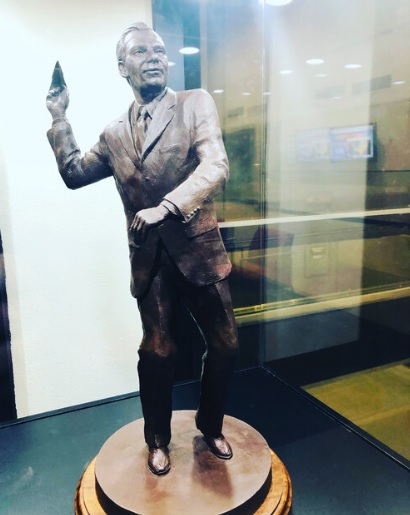
Yes, you could say I was quite daunted by the prospect of meeting these legends when I visited their Headquarters near the appropriately-named Love Field in Dallas Texas.
Let me end the suspense – each and every employee I had the privilege of meeting was spectacular. Classic Southern hospitality mixed with trademark SWA self-effacing humour and chutzpah. But, even more obvious, they all genuinely seemed to love being inside the organization and that love was contagious.
So, what was it that I learned from my time at Southwest Airlines that sets them apart from many organizations today?
What are their Culture secrets?
Time and again, during my visit, I was told: “Ask me anything, and go anywhere, we have nothing to hide.” Anywhere but the airline maintenance hangers where I didn’t have TSA security clearance…and I’d likely break something expensive.
I put it down to 4 “C”’s
That’s it.
4 simple “C’s”.
1) CLARITY
The airline business is an incredibly complicated dance of logistics, unpredictable weather patterns, engineering, finances and human beings. Human beings at their frustrated, scared and irritable worst. Human beings at their delighted, happy and joyous best.
And Southwest Airlines has to deal with and juggle all of that complexity daily.
Doing it with aplomb requires the organization to have absolute crystal clear clarity on how they choose to address that market.
What is their position, their Vision and their Purpose?
In a phrase – “To be the most loved, most flown and most profitable airline”
In the Culture arena, that explicit objective creates an incredible waterfall of actions that permeate the organization and provide a succinct unambiguous filter for decision-making and for employee behaviour at every turn.
- How do we build and train an employee base that will earn the love of our customers?
- How will that customer love translate into loyalty and repeat business, even when there are other choices?
- How will that customer loyalty ensure that we can remain profitable in a competitive and increasingly expensive market?
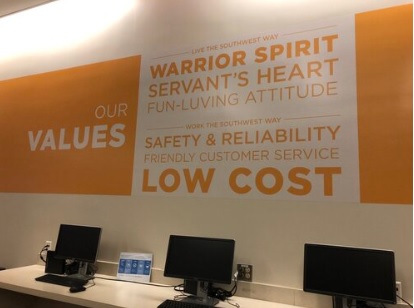
That clarity grounds the organization and creates a virtuous circle of decision-making. In an earlier interview I had with Southwest Airlines Managing Director of Culture Cheryl Hughey, she spoke about the organization being built on a Culture of “expectations” – crystal clear expectations the organization had of its people…and crystal clear expectations Southwest Airlines employees should have of the organization.
That clarity – from Vision to Purpose, to Values, to expected Behaviours – is an absolute basic requirement from which to build any strong organizational culture.
The question to ask your organization is do you have that express clarity? If not, how can you expect to operate at your finest?
2) CONSISTENCY
Time and again, hiring and training came into the Culture conversation. The lead quotation in this post was one of numerous wisdom bombs that the assorted SWA business leaders dropped during our sessions.
Hiring and hiring-for-fit is approached with religious fervour at SWA. Not only is the evaluation process rigorous, but every employee who joins SWA goes through a detailed onboarding regimen to ensure they are true SWA material.
For the stewards who main the planes – and whose on-board antics are a large part of the Southwest customer folklore– that process lasts over a month at SWA U (short for University) at the Love Field HQ. There are expectations of how a SWA employee conducts his or herself and those values and behaviours have been chosen, and stress-tested, for a reason.
That consistency does breed a palpable pride and engagement in each SWA employees you meet.
There is a genuine sense of shared perspective – delivering world-class customer service – and a commonly shared attitude – fun-loving plus a relentless can-do that SWA calls “Warrior Spirit” – that binds the organization. Regardless of function, tenure or seniority that consistency removes all manner of confusion and acts as an accelerant for decision-making in any situation.
There are those would question if consistency doesn’t lead to “group think” and stifles innovation or initiative. Those are legitimate concerns and Southwest Airlines readily acknowledges that consistency can do those things if not constantly monitored and reviewed.
While we were there, there was a robust conversation about the areas that SWA is evolving their Culture. An evolution so they can tackle real 2019 issues of Diversity, Inclusion, Multi-Generational Workforces (they were incredibly proud of having a workforce that spanned 5 generations!) and Workplace Automation.
The ongoing balance of evolution and consistency played out in one session where the discussion centred on the highly-repetitive nature of many of SWA’s operations…areas where, legitimately, repetition and consistency actually translate into safety. Considering the business that Southwest is in, I’ll take consistency every time if it means my safety.
Culture is not something that you can cut and paste. Consistency may actually be the very worst attribute to build inside your Culture. The lesson to take away here is it works for Southwest. It is a deliberate strategic decision to embed consistency into Southwest’s culture because it helps them win in the marketplace.
The question to ask your Culture is what is required in your business, your market, your geography to win…and do you deliver that consistently?
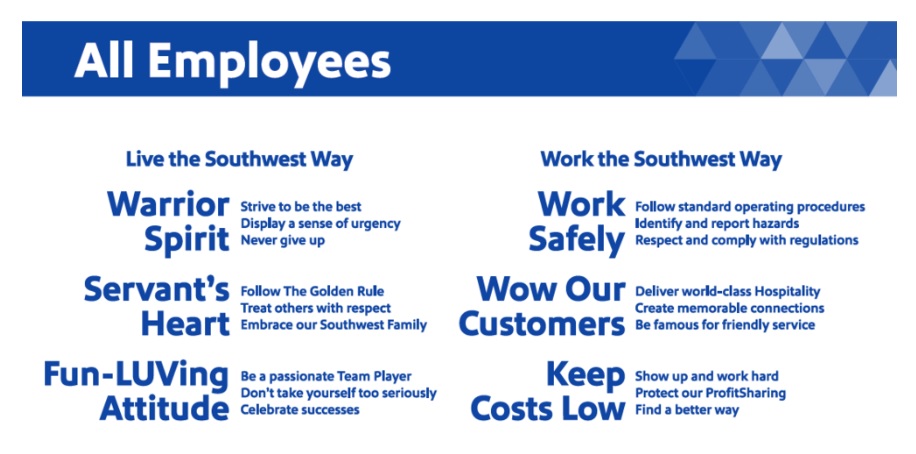
3) COMMITMENT
There’s no extricating the indelible fingerprint of Southwest Airline’s founder Herb Kelleher from this organization.
A statue of Herb adorns the entranceway of the headquarters and colourful and profound “Herb-isms” are festooned on many of the walls but that just speaks to the 3rd “C” of Southwest’s Culture.
Commitment from the very very top of the organization.
When that commitment is articulated in phrases like “The business of business is people” or “We’re in the customer service business, we just happen to fly planes” you get a very keen sense that SWA executives don’t pay lip service to the impact of culture on the bottom line of the organization.
And that commitment descends from the top of the company to the bottom…and all the way back up..
Southwest leaders speak reverently about two events in the history of the organization that highlights their commitment to their employees.
When SWA started out they had merely 4 aircraft and soon ran into financial difficulty that threatened to ground the fledgeling carrier before its 2nd birthday. Rather than laying off people, Herb Kelleher chose to sell one of the fleet to cover wages and operating costs.
And, in doing so, actually increased the pressure on the remaining 3 planes to be operational – and turning around quickly at the gate. From that pressure, Southwest Airlines famous “10-minute turnaround” was born. A turnaround that quickly brought the airline back from the red…and in no small part probably required that consistency we talked about earlier.
During the Iraq invasion of Kuwait when oil prices – a significant component of any airline’s costs – went through the roof, Southwest employees began donating part of their paycheques back to the company to cover rising fuel costs. And to highlight their commitment to the organization they worked for.
Gary Lee, Southwest Airlines current CEO, in costume for the annual Southwest “Rally Days”
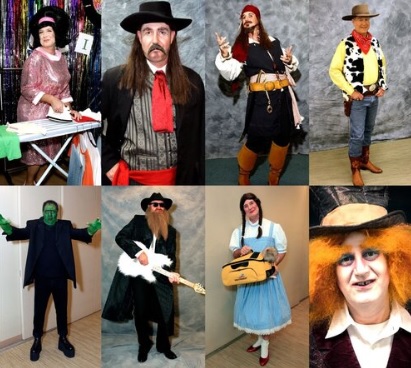
While these are great stories, Southwest leaders were quick to point out that they merely reflect a universal commitment driven by a shared sense of ownership in Southwest’s continued financial performance.
Southwest has always been very progressive in ensuring all employees have ownership in the company and, from that ownership, comes a shared commitment.
One of the people I met quipped that, in his first few months, he was teased by his colleagues for not printing paper on both sides and for “reckless” use of paper-clips.
He didn’t see that as people being spendthrift, but as a remarkable sign of how committed every employee was to ensure the airline could truly deliver on its low-cost philosophy…and reckless wastage, even of paper-clips, would prevent that happening.
That’s commitment!
How committed are your people? Can they draw a straight line between how they deliver their tasks and their job…and the success or failure of the company?
And, of course, you can’t expect commitment from your people if, as the leaders in your organization, you don’t relentlessly model that behaviour and set that example at all times.
Leadership commitment is certainly something SWA’s executives have and continue to, deliver in spades.
4) COMMUNICATION
As a Communication person, the entire environment at Southwest Airlines is a masterclass in communication and reinforcement.
Wherever possible, key messages about the organization are placed as subtle (or not so discreet) reinforcement about what – and who – really matters to Southwest.
From 3-D interactive art pieces – like a spinning wheel dedicated to explaining the “Hospitality Wheel” – to large colourful posters celebrating the new Southwest Airlines colours, everything and everywhere at SWA communicates.
As the good people at Gaping Void Culture Design say, “Culture is an exercise in marketing” – and SWA passes with flying colours.
For some, this onslaught of corporate slogans, historical images tracking the evolution of SWA from a gritty upstart Challenger, to areas dedicated to Inclusion and Diversity (the chairs are all different colours and heights to highlight…that we’re all different) and the constant repetition of the Mission, Vision and Values could be seen as sensory overload.
At Southwest Airlines, it just works.
The communication isn’t just visual. Southwest Airlines relishes collecting and retelling their corporate stories and those, like the time Herb Kelleher challenged another airline boss to an arm-wrestling match, have become part of the corporate folklore.
The myths, urban legends, tall stories and yarns that actually create this wonderful glue amongst Southwest Airlines employees. Each of them has a favourite Herb anecdote – many actually met and worked with Herb – and equally many have a favourite Gary Lee, the current CEO, quip or anecdote.
Lastly, Southwest Airlines recognizes the cohesive power of rituals.
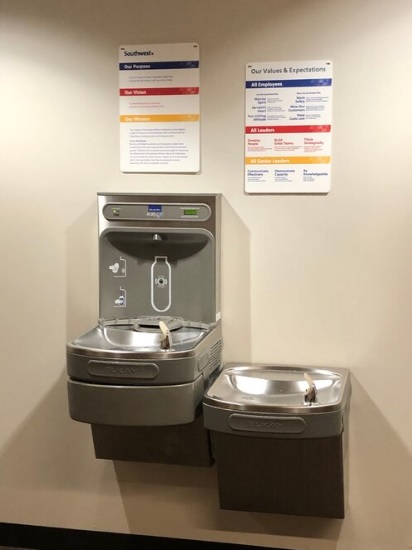
From the ritual of how most (sadly not all) SWA flight announcements are a brilliant and comedic routine to the annual All Staff bonanza called Rally Days, Southwest understands the cohesive power of rituals. Not surprising, for an airline that prides itself on humour and love, each year on Valentine’s Day and Halloween the entire organization goes into a frenzy of dressing up meeting rooms, producing funny videos and dressing up in all manner of weird costumes as an organization-wide ritual.
While these activities might be seen as frivolous and wasteful in many other organizations, Southwest Airlines astutely understands that nothing draws people closer together, or binds them faster, than shared language, shared history and shared experiences.
Southwest Airlines are masters in leveraging Communication to embed, reinforce and celebrate their unique culture.
What communication artefacts, language and rituals does your organization have? What do they communicate – and, more critically, what do they reinforce – about what’s considered important inside your company?
And, to paraphrase Steve Jobs…there’s one more thing…
One final “C”…
COHESION
Spend any time inside Southwest Airlines and it is abundantly clear that each SWA employee knows exactly where and how they contribute to the organization’s success.
They have absolute clarity on what is – and is not – important.
They have received consistent reinforcement, training, reviews and reminders about where the organization is focused, what matters and what’s expected of them.
They see commitment – from the most senior Executives to their peers and colleagues – that what they, and everyone else in the organization is doing, matters. And that commitment isn’t a one-time thing either. As Cheryl Hughey told me so eloquently:
“Culture isn’t a program that you turn on and off. It’s an all-the-time thing because, if it isn’t, your people see through that in an instant.’
And they are surrounded by communications that extol and celebrate what makes Southwest Airlines – and by extension them as employees – unique, different and special.
Is it any wonder Southwest Airlines corporate Culture is so admired?
Is it any wonder that they’ve been consistently profitable for 46 years?
Thank you to everyone who hosted at Southwest Airlines. You’re a credit to your organization and an example to the rest of us.
I leave you with this poignant people-centric piece from SWA.
How entirely fitting!!
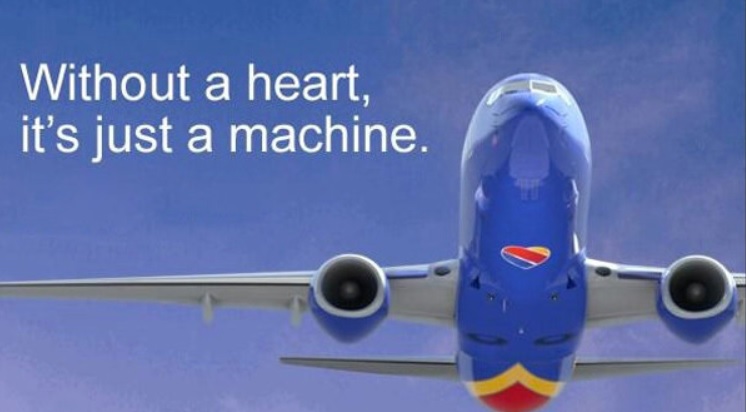
Article by channel:
Everything you need to know about Digital Transformation
The best articles, news and events direct to your inbox







